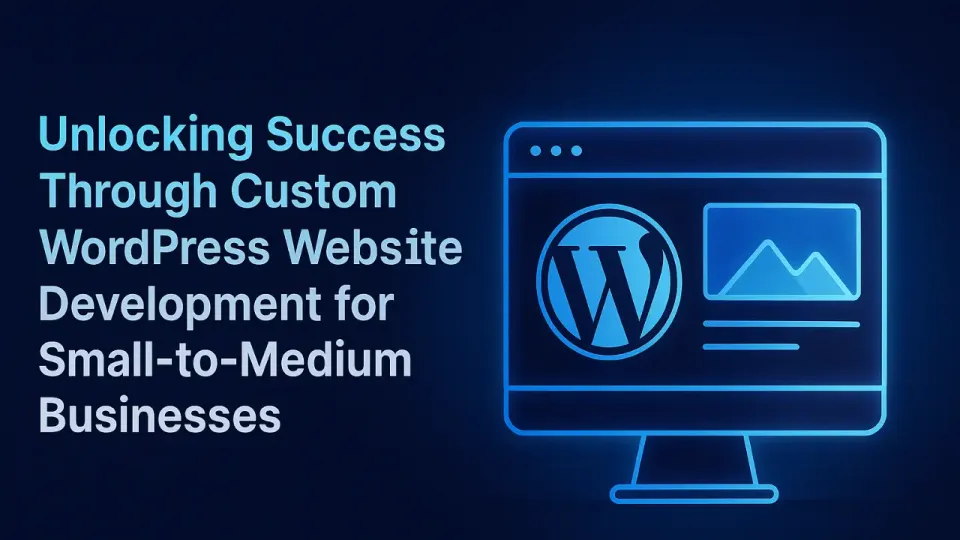Design or Ecommerce Dominance? Squarespace vs. Shopify

In today’s digital landscape, selecting the right platform to build your website can define the success of your business. Whether you're launching a visually stunning portfolio or scaling an online store, the decision often boils down to finding the balance between aesthetic appeal and powerful functionality. Two major players in this space—Squarespace and Shopify—represent different strengths and approaches to web development.
Squarespace is renowned for its sleek, design-forward templates, catering to creatives and businesses that prioritize beautiful visuals and brand identity. On the other hand, Shopify is the undisputed leader in e-commerce, offering robust sales tools and scalability for businesses that need to optimize their online store for growth.
This article explores the strengths and limitations of both platforms, focusing on the central question: Is your business better suited for creative design excellence or e-commerce dominance? By the end, you’ll have a clearer understanding of which platform can help you meet your long-term goals.
Overview of Squarespace and Shopify
Squarespace: The Creative Powerhouse
Squarespace has carved out a unique niche as the go-to platform for businesses and individuals who prioritize aesthetic appeal. Founded in 2004, Squarespace quickly became popular for its sleek, modern templates and easy-to-use website builder. The platform is designed with a drag-and-drop interface, making it accessible to those without coding experience while still offering enough flexibility for advanced customizations.
One of Squarespace’s biggest strengths is its visually stunning designs, which are ideal for creatives, freelancers, and small businesses that want to showcase their work in a polished, professional way. Whether you're a photographer, designer, or boutique business, Squarespace empowers you to create a website that reflects your unique brand identity.
Squarespace also offers essential e-commerce tools, but its core appeal lies in its ability to create immersive, visually driven websites that emphasize storytelling and design. This makes it an ideal choice for users who value aesthetics and brand experience above all else.
Shopify: The E-Commerce Giant
In contrast, Shopify is the dominant platform for businesses that want to focus on selling products online. Founded in 2006, Shopify has grown into a powerhouse that supports over a million businesses worldwide, from small startups to large-scale enterprises. Shopify’s success is largely due to its all-in-one e-commerce capabilities, offering everything from product management and payment gateways to marketing tools and third-party integrations.
Shopify is built for one primary goal: to help businesses sell more online. Its platform is packed with advanced sales features like abandoned cart recovery, multi-channel selling, and extensive inventory management. It also offers a vast app ecosystem, allowing businesses to extend their website's functionality with hundreds of apps tailored to specific needs.
While Shopify is more complex than Squarespace, it is designed to handle the demands of fast-growing online stores. Whether you’re running a small business with plans to scale or an established e-commerce brand looking for robust sales optimization tools, Shopify provides the infrastructure to grow your online store with ease.
Creative Design: A Deep Dive into Squarespace’s Strengths
When it comes to web design, Squarespace is a standout platform known for its sleek, visually driven approach. Whether you're a business owner, artist, or creative professional, Squarespace provides the tools to build beautiful, design-centric websites with ease. Below, we’ll explore the key elements that make Squarespace an ideal choice for users focused on design and brand presentation:
- Award-winning templates designed for visual impact and customization.
- User-friendly drag-and-drop interface that simplifies the design process.
- Mobile-responsive layouts that adapt to all screen sizes.
- Best for portfolios, creative professionals, and small businesses that value aesthetics.
Let’s take a closer look at how Squarespace delivers on these design-focused features.
1. Design Flexibility & Visual Appeal
Squarespace is celebrated for its visually striking templates that make even the simplest websites look professional and polished. These templates are highly customizable, giving users the ability to adjust everything from colors and fonts to spacing and layouts. Without needing to write a single line of code, users can create a personalized website that reflects their brand’s identity.
- Pre-built templates: Professionally designed and customizable to suit a wide range of industries.
- Visual editing tools: Adjust page layouts, background images, fonts, and color schemes with ease.
- Focus on aesthetics: Ideal for businesses that rely on a strong visual presence, such as photographers, designers, and boutique brands.
2. User-Friendly Experience
One of Squarespace’s major strengths is its ease of use, especially for non-technical users. With an intuitive drag-and-drop builder, you can create pages by simply dragging elements (images, text boxes, forms, etc.) into place. No coding or web development experience is required.
- Simplified design process: Easily move elements around, change layouts, and add media.
- Pre-built sections: Squarespace provides pre-designed sections for galleries, contact forms, and more, making it quick to build a professional-looking site.
- Mobile responsiveness: All Squarespace designs are automatically mobile-friendly, so your site looks great on any device without extra effort.
- SEO and analytics: Built-in tools help with basic SEO and offer insights into site performance.
3. Best Use Cases for Squarespace
Squarespace excels in industries where design and branding are critical to success. While it offers basic e-commerce features, it truly shines in its ability to create visually stunning sites for creatives, service-based businesses, and small boutiques.
- Creatives and Freelancers: Perfect for artists, photographers, and designers who need a portfolio that reflects their style and talent.
- Small Businesses and Boutiques: Ideal for service-oriented businesses, local shops, and small online stores that prioritize visual appeal.
- Service-Based Professionals: Consultants, coaches, and service providers can use Squarespace’s templates to present their offerings in a clean, professional format.
Example industries benefiting from Squarespace:
- Photographers showcasing portfolios.
- Designers building a personal brand.
- Small boutiques needing a visually attractive online presence.
Squarespace's focus on design, user experience, and ease of customization make it the go-to platform for businesses and individuals who prioritize aesthetics over complex e-commerce functionalities.
E-Commerce Dominance: How Shopify Leads the Pack
When it comes to building and scaling an online store, Shopify has established itself as the premier platform for e-commerce. Designed specifically for selling products online, Shopify provides businesses with all the tools they need to manage inventory, process transactions, and grow their customer base. Below are the key elements that make Shopify the industry leader in e-commerce:
- Comprehensive sales features built for online stores of any size.
- Scalability and flexibility for growing businesses.
- Extensive app ecosystem to extend the platform’s functionality.
- Optimized for multi-channel selling and global commerce.
Let’s explore the strengths that have made Shopify the go-to platform for e-commerce businesses.
1. Powerful E-Commerce Features
Shopify’s feature set is designed to cater to the needs of serious online sellers, from small startups to large enterprises. The platform offers a range of tools to streamline the e-commerce experience and ensure businesses can manage every aspect of their store efficiently.
- Inventory management: Shopify allows you to track product stock, manage variations (size, color, etc.), and set automatic restock alerts.
- Payment gateways: Shopify integrates with over 100 payment gateways, including Shopify Payments, PayPal, Stripe, and others, giving businesses flexibility in how they accept payments.
- Shipping and fulfillment: The platform simplifies shipping with built-in integrations for major carriers (UPS, FedEx, DHL) and allows for real-time shipping calculations.
- Global commerce support: Shopify supports multi-currency transactions, making it easy for businesses to sell globally.
Whether you’re managing hundreds of products or just a few, Shopify provides the infrastructure to handle complex inventories and streamline order fulfillment.
2. Sales Optimization & Marketing Tools
Shopify doesn’t just help you build an online store—it’s designed to help you sell more. The platform is packed with features that drive conversions and maximize sales, from abandoned cart recovery to multi-channel selling across social media and marketplaces.
- Abandoned cart recovery: Automatically send follow-up emails to customers who leave items in their carts, helping to reclaim lost sales.
- Multi-channel selling: Shopify allows businesses to sell directly through platforms like Facebook, Instagram, Amazon, and eBay, enabling a seamless cross-platform experience.
- Discount codes and promotions: Create and manage sales, discount codes, and promotions to boost customer engagement and conversions.
- Advanced analytics: Shopify’s analytics dashboard provides detailed insights into sales performance, customer behavior, and marketing effectiveness, allowing businesses to make data-driven decisions.
For businesses looking to optimize every step of the sales funnel, Shopify’s built-in marketing and sales tools make it easier to reach and convert customers.
3. Best Use Cases for Shopify
Shopify is the top choice for businesses that prioritize growth, scalability, and advanced e-commerce functionality. It’s designed to handle large inventories, high transaction volumes, and complex shipping needs, making it ideal for online retailers looking to scale quickly.
- Growing E-Commerce Brands: Shopify is perfect for businesses that need to scale and handle a large volume of transactions, making it ideal for online stores with ambitions for rapid growth.
- Multi-Product Retailers: For businesses selling a wide range of products with different variants, Shopify’s robust inventory management and fulfillment features simplify operations.
- Global Sellers: If your business targets an international audience, Shopify’s multi-currency support and global shipping integrations make it easy to expand your reach.
Example industries benefiting from Shopify:
- Established online retailers managing large product inventories.
- Entrepreneurs launching fast-growing e-commerce brands.
- Businesses looking to sell across multiple platforms and regions.
Shopify’s focus on scalability, powerful e-commerce features, and sales optimization tools makes it the top choice for businesses serious about online selling. Whether you're just starting or scaling to new heights, Shopify provides the robust infrastructure needed for long-term e-commerce success.
Pricing and Affordability: Which Offers Better Value?
Choosing between Squarespace and Shopify often comes down to understanding the pricing models and what each platform offers for your investment. Both platforms have tiered pricing structures that cater to different business needs, but the costs and value they provide vary significantly depending on whether your priority is design or e-commerce functionality.
1. Squarespace Pricing Structure
Squarespace offers a straightforward pricing model with four main plans, each including access to its design tools and templates. While all plans allow for basic website creation, only the higher tiers support more advanced e-commerce features.
- Personal Plan: $16/month – This plan is ideal for personal blogs or portfolios, but it lacks e-commerce functionality.
- Business Plan: $23/month – Offers basic e-commerce capabilities, along with additional design customization and marketing features.
- Basic Commerce Plan: $27/month – Designed for small businesses, this plan eliminates transaction fees and offers more comprehensive e-commerce tools, such as customer accounts and integration with Instagram shopping.
- Advanced Commerce Plan: $49/month – Includes all of Squarespace’s e-commerce features, such as advanced shipping, discounts, and abandoned cart recovery.
Who is this pricing best for?
- Squarespace’s pricing is ideal for small businesses, freelancers, and creatives who prioritize beautiful design and don’t require advanced e-commerce tools.
- For businesses with simpler product catalogs or service-based industries, the lower pricing tiers provide solid value.
2. Shopify Pricing Breakdown
Shopify’s pricing structure is built around its core e-commerce capabilities, which means even its entry-level plan is tailored for online selling. However, additional costs can accrue based on the apps and add-ons you need to extend functionality.
- Basic Shopify Plan: $39/month – This plan covers all the essentials to start an online store, including unlimited products, two staff accounts, and basic e-commerce features like payment processing and order management.
- Shopify Plan: $105/month – Provides advanced reporting, professional reports, and up to five staff accounts, making it better suited for growing businesses with more complex needs.
- Advanced Shopify Plan: $399/month – This plan is built for scaling businesses, offering advanced reporting, third-party calculated shipping rates, and up to 15 staff accounts.
- Shopify Plus: Starting at $2,000/month – Enterprise-level solution for high-volume merchants and large e-commerce businesses that need custom solutions, additional support, and more advanced features.
In addition to the plan costs, there are transaction fees for non-Shopify payment gateways and additional fees for apps that extend functionality (e.g., for marketing automation, SEO tools, or shipping integrations).
Who is this pricing best for?
- Shopify’s pricing is best for e-commerce-driven businesses, especially those looking to scale and sell across multiple channels.
- Even at higher costs, Shopify offers immense value for businesses that need a full suite of e-commerce tools and customization options.
3. Which Platform Provides Better ROI?
- Squarespace ROI: For businesses prioritizing design, visual branding, or offering a limited number of products, Squarespace provides an excellent return on investment. Its pricing is lower, and it includes essential features for building and maintaining an attractive website.
- Shopify ROI: For businesses focused on serious e-commerce, Shopify’s pricing reflects the value of its robust, scalable features. Though the cost is higher, businesses that need powerful sales tools, global commerce capabilities, and advanced integrations will find the higher investment worthwhile.
Key Considerations:
- Squarespace: Better for small to mid-sized businesses that prioritize affordability and visual appeal over advanced e-commerce tools.
- Shopify: Best for businesses that plan to grow or need a platform that can handle large volumes of sales, manage complex inventories, and scale across multiple channels.
Ultimately, which platform offers better value depends on your business goals—whether you're seeking a cost-effective, design-first platform (Squarespace) or investing in a powerful e-commerce engine with room to scale (Shopify).
Usability and Customization: Which Platform is More Flexible?
When choosing a website platform, ease of use and customization are crucial factors. Both Squarespace and Shopify offer different strengths in terms of how easily users can create and manage their websites, as well as how much customization is available for advanced needs. Here’s how they compare:
1. Ease of Use: Squarespace
Squarespace is widely recognized for its simplicity and user-friendly design interface, making it an ideal choice for beginners or users with minimal technical knowledge.
- Drag-and-drop builder: Squarespace’s intuitive drag-and-drop interface allows users to easily add, move, and modify elements on their website. This functionality is perfect for creating beautiful, professional sites without coding.
- Minimal learning curve: Even first-time users can build a fully functional website quickly, thanks to the platform’s straightforward tools and pre-built content blocks.
- Pre-designed templates: The templates come fully formatted and responsive, which means minimal tweaking is needed to get a polished look. Customization options are accessible and simple to apply.
- Limitations for advanced users: While Squarespace is easy to use, its flexibility is limited when it comes to more advanced customization, especially for those looking to add custom code or highly specific features.
Best suited for: Beginners, creatives, and small businesses who want a simple, elegant, and easy-to-build website without getting into the technical aspects of web development.
2. Flexibility: Shopify
Shopify is more technically advanced, offering greater flexibility for customization, especially for businesses looking to scale or add unique functionalities. However, this increased flexibility often requires a steeper learning curve, particularly for users who want to take advantage of Shopify’s advanced features.
- Custom themes: Shopify provides a wide range of customizable themes, and with access to the HTML, CSS, and Shopify’s proprietary Liquid code, users have significant control over the look and feel of their site.
- App integrations: Shopify’s app store is vast, offering thousands of third-party apps and plugins that can extend the platform’s functionality. Whether it’s integrating advanced analytics tools, adding customer loyalty programs, or enhancing marketing features, Shopify’s ecosystem allows businesses to tailor their site to specific needs.
- Coding for customization: Developers and businesses with technical expertise can tap into Shopify’s Liquid language to customize their store’s features and functionalities beyond what is available through the native interface or app store.
- Steeper learning curve: While the platform offers great customization, non-technical users might find it more challenging to navigate the back-end or make substantial design changes without hiring a developer.
Best suited for: Businesses that prioritize growth, need advanced e-commerce functionality, or want a highly customizable online store. Shopify provides more flexibility but requires more effort or technical know-how to fully unlock its potential.
3. Developer Freedom
For businesses with specific requirements or those that want to create a truly unique website, the level of developer access can be a key differentiator.
- Squarespace: While Squarespace offers access to custom CSS and some limited code injection, the platform’s customization capabilities are largely constrained by the templates and pre-built elements. This makes it harder for developers to create highly customized features or deeply modify the core structure of the site.
- Shopify: Shopify offers much greater flexibility for developers, allowing full access to the platform’s code (Liquid), HTML, CSS, and JavaScript. Developers can create custom functionalities, integrate with external systems, or build apps to meet specific business needs. Shopify also has a large community of developers who specialize in building custom apps and themes.
Best suited for: Businesses that require high levels of customization, advanced integrations, or specific e-commerce features not supported by native tools.
Squarespace VS Shopify
Summary of Usability and Customization:
- Squarespace: Best for users seeking a simple, easy-to-use platform with limited customization needs. Its drag-and-drop interface makes it perfect for creatives and small businesses focused on design and simplicity.
- Shopify: Offers a more complex but highly customizable platform, making it ideal for businesses that need advanced e-commerce capabilities and are willing to invest in customization to scale their online store.
In the end, your choice between Squarespace and Shopify comes down to the importance of ease of use versus flexibility. Squarespace is excellent for design-focused websites with minimal e-commerce needs, while Shopify is the better option for businesses that require robust customization and powerful e-commerce tools.
SEO and Marketing Capabilities: Driving Traffic and Growing Your Business
When choosing a website platform, effective search engine optimization (SEO) and marketing tools are crucial for driving traffic and growing your online presence. Here’s how Squarespace and Shopify stack up in these areas.
1. SEO Features: Squarespace
Squarespace provides essential SEO tools that make it straightforward for users to optimize their websites.
- Built-in SEO tools: Users can customize page titles, meta descriptions, and alt text, while Squarespace automatically generates clean URLs and a sitemap.
- Mobile optimization and SSL security: All templates are mobile-responsive, and free SSL certificates enhance security, which positively impacts search engine rankings.
- Limitations: While it covers basic SEO needs, Squarespace has less control over advanced features like structured data compared to Shopify.
Best suited for: Small businesses and creatives seeking a simple, user-friendly platform to manage basic SEO tasks without deep technical knowledge.
2. SEO Features: Shopify
Shopify offers a more comprehensive suite of SEO tools that are particularly beneficial for e-commerce businesses.
- Customizable SEO elements: Shopify allows for detailed edits to product pages, including titles, descriptions, and alt tags. It also generates a sitemap automatically.
- Speed and performance: Faster loading times improve search rankings, and the platform is optimized for larger inventories.
- Advanced features: Shopify supports more complex SEO strategies, making it ideal for businesses looking to compete in crowded markets.
Best suited for: E-commerce businesses that require advanced SEO capabilities and need to optimize large product catalogs.
3. Marketing Tools: Squarespace
Squarespace includes basic marketing tools that help users attract and retain customers.
- Email marketing: Built-in Email Campaigns allow users to create and track campaigns easily.
- Social media integration: Users can connect their site to social media platforms for seamless sharing.
- Basic analytics: Squarespace provides an analytics dashboard to track visitor behavior and traffic sources, but lacks the depth of Shopify’s reporting.
Best suited for: Small businesses and creatives needing user-friendly marketing tools integrated with their website.
4. Marketing Tools: Shopify
Shopify’s marketing features are tailored for serious e-commerce businesses looking to drive sales.
- Email marketing integrations: Shopify connects with various email marketing services and offers its own email tool for automated campaigns.
- Multi-channel selling: The platform supports selling across multiple channels, including social media and online marketplaces.
- Advanced analytics: Shopify provides in-depth data insights into sales performance, customer behavior, and marketing effectiveness, helping businesses make data-driven decisions.
Best suited for: E-commerce businesses that want to leverage advanced marketing strategies and scale their efforts.
In summary, your choice between Squarespace and Shopify will depend on your specific SEO and marketing needs, with Shopify providing a more robust solution for e-commerce-focused businesses.
Conclusion: Choosing the Right Platform for Your Needs
Selecting between Squarespace and Shopify ultimately depends on your specific business goals and priorities. Here’s a quick recap of the key differences:
- Squarespace is ideal for creatives, freelancers, and small businesses focused on aesthetics and ease of use. Its user-friendly interface, beautiful templates, and built-in marketing tools make it a great choice for those who prioritize design over extensive e-commerce capabilities.
- Shopify, on the other hand, is tailored for serious e-commerce businesses that require advanced features, scalability, and customization. With its robust inventory management, extensive SEO tools, and multi-channel selling capabilities, Shopify is designed for those looking to grow their online sales and optimize their marketing efforts.
In conclusion, if your primary focus is on building a visually stunning website with basic e-commerce functionality, Squarespace is the way to go. However, if you’re serious about online selling and need a powerful platform to support your growth, Shopify is the better choice. Consider your unique needs, budget, and long-term goals to make the best decision for your business.
"Joining this community has been a game-changer for staying updated on the latest trends & events!" - John B.





